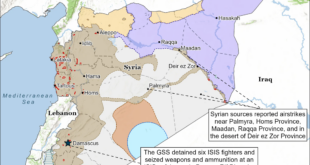The threat of cyberattacks looms larger than ever before. Recent global intelligence assessments and cybersecurity industry reports have warned that the frequency, sophistication and scale of cyberattacks are expected to rise dramatically in the coming years.
Governments, corporations and even small businesses are increasingly becoming targets as cybercriminals leverage artificial intelligence, machine learning and automation to penetrate digital systems. In a report released last week, the UK’s National Cyber Security Centre explicitly highlighted the emerging risks of AI-powered cyberattacks, warning that as societies integrate more digital tools into everyday life, vulnerabilities multiply.
This trend is not limited to Western powers or Asia; it has far-reaching implications for every region of the world. Among the most affected — and increasingly exposed — is the Middle East, a region undergoing vast digital transformation amid complex geopolitical realities.
The Middle East’s vulnerability to cyber threats is heightened by a confluence of strategic, economic and technological factors. This region is home to some of the world’s most important oil and gas reserves, financial institutions and government infrastructures. Simultaneously, it is also a region experiencing some of the world’s fastest economic growth and technological advancement.
As nations in the Gulf Cooperation Council, such as Saudi Arabia, the UAE and Qatar, pivot away from hydrocarbon-dependent economies toward knowledge-based and digitally integrated systems, they also become increasingly exposed to cyber risks. These developments make the cybersecurity landscape in the Middle East not only a national concern but a regional and even a global issue.
Over the past decade, Gulf nations have embarked on ambitious economic transformation plans, such as Saudi Arabia’s Vision 2030 and the UAE Centennial 2071. These initiatives aim to diversify income sources, attract foreign investment and modernize economies by leveraging advanced technologies, infrastructure and human capital. This economic momentum is tangible in the massive construction projects, expanding financial sectors and burgeoning tech ecosystems across the region. Yet, with rapid growth comes increased exposure to cybercrime, intellectual property theft, financial fraud and digital espionage.
Parallel to economic expansion is the sweeping digital transformation reshaping the Middle East. Across government ministries, oil fields, banks, healthcare systems and educational institutions, digital technologies are being adopted at an unprecedented rate. Smart cities like NEOM in Saudi Arabia and Masdar City in the UAE are being built on digital foundations, employing AI, Internet of Things, blockchain and big data analytics. Governments are introducing e-services, digitizing healthcare records and automating judicial systems to improve efficiency and transparency.
The banking sector is also rapidly moving toward mobile banking and fintech solutions, while energy companies are incorporating automated control systems to optimize production and distribution. These transformations — while necessary and laudable — open the door to sophisticated cyberattacks.
It is precisely because of this intersection between economic ambition and digital vulnerability that countries in the Middle East must act with urgency. Investment in cybersecurity infrastructure, education and governance must not be treated as an afterthought but as an essential pillar of national development. Several countries have begun to take meaningful steps.
Saudi Arabia, for instance, has positioned itself as a regional leader in cybersecurity preparedness. The Kingdom established its National Cybersecurity Authority to govern and standardize cybersecurity frameworks across both the public and private sectors. It has implemented the Essential Cybersecurity Controls, a comprehensive framework that requires government and critical infrastructure institutions to meet strict cybersecurity standards.
These efforts are complemented by a national cybersecurity strategy that integrates threat detection, emergency response capabilities and long-term strategic planning. In recognition of its progress, Saudi Arabia was awarded a perfect score in the UN Global Cybersecurity Index in 2024 and named a “role model” country.
Several industries in the Middle East are particularly vulnerable to cyberattacks. Government institutions are a prime target, with about 25 percent of cyberattacks in 2024 being directed at public sector systems. These attacks often aim to steal sensitive information, disable services or project political messages.
The energy sector is another high-risk domain. Oil and gas companies rely on a vast network of digital controls, sensors and operational technology that, if compromised, can cause operational shutdowns or even physical damage. Financial institutions, which increasingly rely on mobile platforms and digital transactions, face threats ranging from phishing scams to data breaches.
Telecommunications companies are also under constant pressure, especially as they form the backbone of national connectivity. With the expansion of 5G and satellite internet in the region, the attack surface has broadened, making it easier for hackers to access critical data and communication streams.
To counter these escalating threats, Middle Eastern nations must take a multilayered approach to cybersecurity readiness. First and foremost, there must be sustained investment in cybersecurity infrastructure — firewalls, encryption protocols, endpoint protection and real-time monitoring systems. Governments must mandate the implementation of security standards across all sectors, ensuring that digital adoption does not outpace cyber defense capabilities.
Just as important is the human element. There is a growing demand for skilled cybersecurity professionals across the region. Educational institutions should establish specialized programs, scholarships and training centers to build a robust pipeline of talent. Additionally, the private sector must be engaged as a key partner.
Another vital strategy involves regional cooperation. Cyber threats do not respect borders and, therefore, nations must collaborate — sharing intelligence, coordinating emergency responses and developing regional cybersecurity norms. Public-private partnerships can also foster innovation in the field, incentivizing the development of indigenous cybersecurity startups and solutions tailored to regional needs.
Moreover, attention must be paid to supply chain security. With many institutions relying on third-party vendors for hardware, software and services, it is essential to implement rigorous vetting and monitoring processes to prevent vulnerabilities from being introduced indirectly.
In conclusion, the threat of cyberattacks is a present and growing danger, and the Middle East is particularly vulnerable given its pace of transformation and strategic importance. The region’s ongoing digital and economic revolutions, while promising immense benefits, also necessitate an equally aggressive approach to cybersecurity. Countries such as Saudi Arabia have already taken exemplary steps by investing in infrastructure, cultivating local talent and creating governance frameworks. Other nations would do well to follow suit, recognizing that cybersecurity is not a luxury — it is a necessity for stability, prosperity and sovereignty. The cost of inaction is too high and the window for preparedness is closing.
 Eurasia Press & News
Eurasia Press & News




